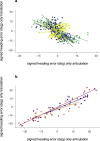Combining biological motion perception with optic flow analysis for self-motion in crowds
- PMID: 32902593
- PMCID: PMC7488621
- DOI: 10.1167/jov.20.9.7
Combining biological motion perception with optic flow analysis for self-motion in crowds
Abstract
Heading estimation from optic flow relies on the assumption that the visual world is rigid. This assumption is violated when one moves through a crowd of people, a common and socially important situation. The motion of people in the crowd contains cues to their translation in the form of the articulation of their limbs, known as biological motion. We investigated how translation and articulation of biological motion influence heading estimation from optic flow for self-motion in a crowd. Participants had to estimate their heading during simulated self-motion toward a group of walkers who collectively walked in a single direction. We found that the natural combination of translation and articulation produces surprisingly small heading errors. In contrast, experimental conditions that either present only translation or only articulation produced strong idiosyncratic biases. The individual biases explained well the variance in the natural combination. A second experiment showed that the benefit of articulation and the bias produced by articulation were specific to biological motion. An analysis of the differences in biases between conditions and participants showed that different perceptual mechanisms contribute to heading perception in crowds. We suggest that coherent group motion affects the reference frame of heading perception from optic flow.
Figures










Similar articles
-
Visual perception of travel distance for self-motion through crowds.J Vis. 2023 Apr 3;23(4):7. doi: 10.1167/jov.23.4.7. J Vis. 2023. PMID: 37099279 Free PMC article.
-
Illusory percepts of curvilinear self-motion when moving through crowds.J Vis. 2023 Dec 4;23(14):6. doi: 10.1167/jov.23.14.6. J Vis. 2023. PMID: 38112491 Free PMC article.
-
Heading Through a Crowd.Psychol Sci. 2018 Sep;29(9):1504-1514. doi: 10.1177/0956797618778498. Epub 2018 Jul 13. Psychol Sci. 2018. PMID: 30004826
-
How Optic Flow and Inertial Cues Improve Motion Perception.Cold Spring Harb Symp Quant Biol. 2014;79:141-8. doi: 10.1101/sqb.2014.79.024638. Cold Spring Harb Symp Quant Biol. 2014. PMID: 26092884 Review.
-
Walking humans and running mice: perception and neural encoding of optic flow during self-motion.Philos Trans R Soc Lond B Biol Sci. 2023 Jan 30;378(1869):20210450. doi: 10.1098/rstb.2021.0450. Epub 2022 Dec 13. Philos Trans R Soc Lond B Biol Sci. 2023. PMID: 36511417 Free PMC article. Review.
Cited by
-
Visual perception of travel distance for self-motion through crowds.J Vis. 2023 Apr 3;23(4):7. doi: 10.1167/jov.23.4.7. J Vis. 2023. PMID: 37099279 Free PMC article.
-
Illusory percepts of curvilinear self-motion when moving through crowds.J Vis. 2023 Dec 4;23(14):6. doi: 10.1167/jov.23.14.6. J Vis. 2023. PMID: 38112491 Free PMC article.
-
Limb articulation of biological motion can induce illusory motion perception during self-motion.Iperception. 2024 May 27;15(3):20416695241246755. doi: 10.1177/20416695241246755. eCollection 2024 May-Jun. Iperception. 2024. PMID: 38903983 Free PMC article.
-
Flow parsing and biological motion.Atten Percept Psychophys. 2021 May;83(4):1752-1765. doi: 10.3758/s13414-020-02217-6. Epub 2021 Feb 24. Atten Percept Psychophys. 2021. PMID: 33629261 Free PMC article.
References
-
- Bruss A. R., & Horn B. K. (1983). Passive navigation. Computer Vision, Graphics, and Image Processing , 21(1), 3–20, 10.1016/S0734-189X(83)80026-7. - DOI
-
- Buswell G. T. (1935). How people look at pictures: A study of the psychology and perception in art. Oxford: The University of Chicago Press..
Publication types
MeSH terms
LinkOut - more resources
Full Text Sources

